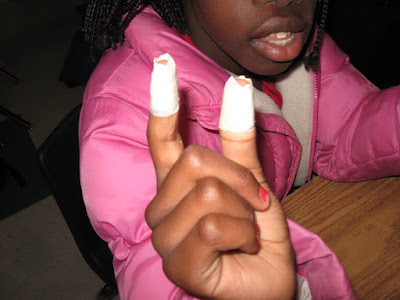




This week we made electromagnets. We watched a video that I found on a google search on how to make them that I showed it to students (I have made them for several years but I was trying to show students how easy it was and if they forgot they could look it up). We read our RH assignment about electromagnets and their uses and then started to build our electromagnets.
Pictured above is the tray of supplies that each table received. We found that metal paperclips worked better then the plastic coated colored paperclips that I have pictured.
The tape on the fingers was an idea I got one year from another teacher. We have battery holders in our science kit but the clasps were hard for the students to use (discovered last year). The batteries heat up when held and the tape is a way to keep fingers from getting too hot. The students loved putting tape on their fingers and comparing how hot the batteries got (they never got hot enough to worry about...but you know how students over react :)
The next day we reviewed electromagnets, uses, and how to make (focusing on how to make them stronger and weaker - which is one of the standards).
Students made a foldable for the right hand side of their notebook. The cover had to have a picture of an electromagnet and under each flap they had to indicate what they could do with each of the materials to make the electromagnet stronger or weaker (pictures above).
Comments
Hope that helps! Good luck.
Eve